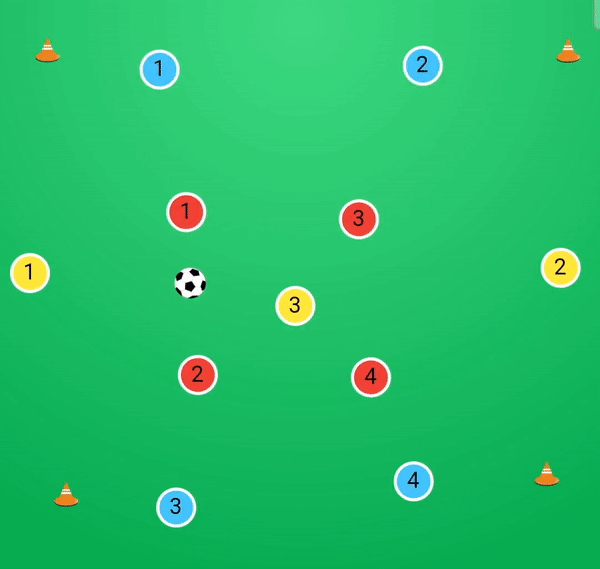Situations cannot be predicted. No two games are the same. Every situation is different. That’s why it makes little sense to rehearse fixed moves. It is better to give the players guidelines/principles with which they can solve the most varied situations. Therefore, the core of the training should consist of game forms that provoke certain situations.
This complexity of soccer can only be poorly represented in exercise forms. However, they also have their justification. We recommend exercise forms in the following situations to:
- Illustrate principles,
- Train contents that rarely appear in game forms (for example, overhead kick),
- To specifically improve technical/coordinative problems, or
- As a possibility for load control.
Below we present a few forms of exercises and games. The game forms are divided into the following categories here:
- Rondo (Fixed outnumber vs. fixed outnumber on possession).
- Positional play (possession play with neutral players, i.e. alternating over/under situations)
- Possession Game (Ball Possession)
- SSG (Small Sided Games; Small Groups on Goals)
Exercise form: Passing in the square
The simple form of the exercise reduces the complexity, as there are no opponents. The players can therefore consciously concentrate on the principles (e.g. open position).

Rondo Basic
Often used as a warm-up game, can be used very well in rondo forms to internalize individual principles.
Tip: Focus on a maximum of one principle at a time to see quick learning results (e.g., focus only on the right foot).

Positional Play: 4 vs. 4 + 3N
The contents of the rondo are now transferred to a more demanding game form. Due to the changing outnumbering and outnumbering situations, the factor ‘switching’ plays a major role. In addition to the individual, the group tactical content is now also in focus.

Possession Game on Goals in Field
This form of the game provokes constant shifting. To facilitate it in the beginning it is also possible to start with neutral players. The number of goals is higher than the number of players, so the defensive team must defend ball-oriented.

SSG with Pass in Depth
The game itself is the most complex, but also the most competitive form of the game. Now all the requirements of the game are required simultaneously.

Conclusion
With these forms of training we adhere to the methodological principle “from the simple to the complex”. All the requirements of the game are trained simultaneously. Within the given framework (playing field, rules, teams), the players always retain maximum freedom of decision. The principles serve as a kind of guideline to resolve situations in a replicable way. At the same time, uniform use of principles facilitates communication within the team and reduces the number of misunderstandings.
We hope that with this small blog series we could give you a first understanding of positional play and its principles. If you found this article interesting, we would be happy if you subscribe to our blog. We plan to present and discuss more interesting topics in the future. What topic would interest you? Let us know!
Your drillstars team
